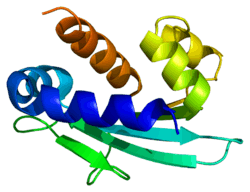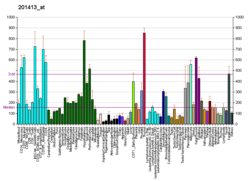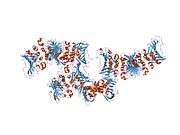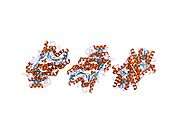HSD17B4
D-bifunctional protein (DBP), also known as peroxisomal multifunctional enzyme type 2 (MFP-2), as well as 17β-hydroxysteroid dehydrogenase type IV (17β-HSD type IV) is a protein that in humans is encoded by the HSD17B4 gene.[5][6][7][8] It's an alcohol oxidoreductase, specifically 17β-Hydroxysteroid dehydrogenase. It is involved in fatty acid β-oxidation and steroid metabolism (cf. steroidogenesis).[8]
The HSD17B4 gene encodes an enzyme involved in peroxisomal fatty acid beta-oxidation. It was first identified as a 17-beta-estradiol dehydrogenase (Leenders et al., 1996; van Grunsven et al., 1998). Peroxisomal beta-oxidation of fatty acids, originally described by Lazarow and de Duve (1976), is catalyzed by 3 enzymes: acyl-CoA oxidase (see, e.g., ACOX1, MIM 609751); the 'D-bifunctional enzyme,' with enoyl-CoA hydratase and D-3-hydroxyacyl-CoA dehydrogenase activity, and 3-ketoacyl-CoA thiolase (MIM 604054).
See also the L-bifunctional peroxisomal protein (EHHADH; MIM 607037). The D- and L-bifunctional proteins have different substrate specificities. The D-bifunctional protein catalyzes the formation of 3-ketoacyl-CoA intermediates from both straight-chain and 2-methyl-branched-chain fatty acids and also acts in shortening cholesterol for bile acid formation. In contrast, the L-specific bifunctional protein does not have the latter 2 activities (Jiang et al., 1997).[supplied by OMIM][7]
See also
References
- 1 2 3 GRCh38: Ensembl release 89: ENSG00000133835 - Ensembl, May 2017
- 1 2 3 GRCm38: Ensembl release 89: ENSMUSG00000024507 - Ensembl, May 2017
- ↑ "Human PubMed Reference:".
- ↑ "Mouse PubMed Reference:".
- ↑ Leenders F, Prescher G, Dolez V, Begue A, de Launoit Y, Adamski J (Mar 1997). "Assignment of human 17 beta-hydroxysteroid dehydrogenase IV to chromosome 5q2 by fluorescence in situ hybridization". Genomics. 37 (3): 403–4. doi:10.1006/geno.1996.0578. PMID 8938456.
- ↑ Persson B, Kallberg Y, Bray JE, Bruford E, Dellaporta SL, Favia AD, Duarte RG, Jornvall H, Kavanagh KL, Kedishvili N, Kisiela M, Maser E, Mindnich R, Orchard S, Penning TM, Thornton JM, Adamski J, Oppermann U (Feb 2009). "The SDR (short-chain dehydrogenase/reductase and related enzymes) nomenclature initiative". Chem Biol Interact. 178 (1–3): 94–8. doi:10.1016/j.cbi.2008.10.040. PMC 2896744. PMID 19027726.
- 1 2 "Entrez Gene: HSD17B4 hydroxysteroid (17-beta) dehydrogenase 4".
- 1 2 Huyghe S, Mannaerts GP, Baes M, Van Veldhoven PP (2006). "Peroxisomal multifunctional protein-2: the enzyme, the patients and the knockout mouse model". Biochim. Biophys. Acta. 1761 (9): 973–94. doi:10.1016/j.bbalip.2006.04.006. PMID 16766224.
Further reading
- de Launoit Y, Adamski J (1999). "Unique multifunctional HSD17B4 gene product: 17beta-hydroxysteroid dehydrogenase 4 and D-3-hydroxyacyl-coenzyme A dehydrogenase/hydratase involved in Zellweger syndrome". J. Mol. Endocrinol. 22 (3): 227–40. doi:10.1677/jme.0.0220227. PMID 10343282.
- Huyghe S, Mannaerts GP, Baes M, Van Veldhoven PP (2006). "Peroxisomal multifunctional protein-2: the enzyme, the patients and the knockout mouse model". Biochim. Biophys. Acta. 1761 (9): 973–94. doi:10.1016/j.bbalip.2006.04.006. PMID 16766224.
- Palosaari PM, Hiltunen JK (1990). "Peroxisomal bifunctional protein from rat liver is a trifunctional enzyme possessing 2-enoyl-CoA hydratase, 3-hydroxyacyl-CoA dehydrogenase, and delta 3, delta 2-enoyl-CoA isomerase activities". J. Biol. Chem. 265 (5): 2446–9. PMID 2303409.
- Adamski J, Normand T, Leenders F, et al. (1995). "Molecular cloning of a novel widely expressed human 80 kDa 17 beta-hydroxysteroid dehydrogenase IV". Biochem. J. 311 (2): 437–43. PMC 1136019. PMID 7487879.
- Markus M, Husen B, Adamski J (1996). "The subcellular localization of 17 beta-hydroxysteroid dehydrogenase type 4 and its interaction with actin". J. Steroid Biochem. Mol. Biol. 55 (5–6): 617–21. doi:10.1016/0960-0760(95)00213-8. PMID 8547189.
- Jiang LL, Kobayashi A, Matsuura H, et al. (1997). "Purification and properties of human D-3-hydroxyacyl-CoA dehydratase: medium-chain enoyl-CoA hydratase is D-3-hydroxyacyl-CoA dehydratase". J. Biochem. 120 (3): 624–32. doi:10.1093/oxfordjournals.jbchem.a021458. PMID 8902629.
- Jiang LL, Miyazawa S, Souri M, Hashimoto T (1997). "Structure of D-3-hydroxyacyl-CoA dehydratase/D-3-hydroxyacyl-CoA dehydrogenase bifunctional protein". J. Biochem. 121 (2): 364–9. doi:10.1093/oxfordjournals.jbchem.a021596. PMID 9089413.
- Jiang LL, Kurosawa T, Sato M, et al. (1997). "Physiological role of D-3-hydroxyacyl-CoA dehydratase/D-3-hydroxyacyl-CoA dehydrogenase bifunctional protein". J. Biochem. 121 (3): 506–13. doi:10.1093/oxfordjournals.jbchem.a021615. PMID 9133619.
- Novikov D, Dieuaide-Noubhani M, Vermeesch JR, et al. (1997). "The human peroxisomal multifunctional protein involved in bile acid synthesis: activity measurement, deficiency in Zellweger syndrome and chromosome mapping". Biochim. Biophys. Acta. 1360 (3): 229–40. doi:10.1016/s0925-4439(97)00003-3. PMID 9197465.
- Suzuki Y, Jiang LL, Souri M, et al. (1997). "D-3-hydroxyacyl-CoA dehydratase/D-3-hydroxyacyl-CoA dehydrogenase bifunctional protein deficiency: a newly identified peroxisomal disorder". Am. J. Hum. Genet. 61 (5): 1153–62. doi:10.1086/301599. PMC 1716023. PMID 9345094.
- van Grunsven EG, van Berkel E, IJlst L, et al. (1998). "Peroxisomal D-hydroxyacyl-CoA dehydrogenase deficiency: resolution of the enzyme defect and its molecular basis in bifunctional protein deficiency". Proc. Natl. Acad. Sci. U.S.A. 95 (5): 2128–33. doi:10.1073/pnas.95.5.2128. PMC 19272. PMID 9482850.
- Dong Y, Qiu QQ, Debear J, et al. (1999). "17Beta-hydroxysteroid dehydrogenases in human bone cells". J. Bone Miner. Res. 13 (10): 1539–46. doi:10.1359/jbmr.1998.13.10.1539. PMID 9783542.
- Leenders F, Dolez V, Begue A, et al. (1999). "Structure of the gene for the human 17beta-hydroxysteroid dehydrogenase type IV". Mamm. Genome. 9 (12): 1036–41. doi:10.1007/s003359900921. PMID 9880674.
- Green VL, Speirs V, Landolt AM, et al. (1999). "17Beta-hydroxysteroid dehydrogenase type 1, 2, 3, and 4 expression and enzyme activity in human anterior pituitary adenomas". J. Clin. Endocrinol. Metab. 84 (4): 1340–5. doi:10.1210/jc.84.4.1340. PMID 10199776.
- van Grunsven EG, Mooijer PA, Aubourg P, Wanders RJ (1999). "Enoyl-CoA hydratase deficiency: identification of a new type of D-bifunctional protein deficiency". Hum. Mol. Genet. 8 (8): 1509–16. doi:10.1093/hmg/8.8.1509. PMID 10400999.
- Itoh M, Suzuki Y, Takashima S (1999). "A novel peroxisomal enzyme, D-3-hydroxyacyl-CoA dehydratase/D-3-hydroxyacyl-CoA dehydrogenase bifunctional protein: its expression in the developing human brain". Microsc. Res. Tech. 45 (6): 383–8. doi:10.1002/(SICI)1097-0029(19990615)45:6<383::AID-JEMT5>3.0.CO;2-7. PMID 10402265.
- Möller G, Leenders F, van Grunsven EG, et al. (1999). "Characterization of the HSD17B4 gene: D-specific multifunctional protein 2/17beta-hydroxysteroid dehydrogenase IV". J. Steroid Biochem. Mol. Biol. 69 (1–6): 441–6. doi:10.1016/S0960-0760(99)00066-7. PMID 10419023.
- Haapalainen AM, van Aalten DM, Meriläinen G, et al. (2001). "Crystal structure of the liganded SCP-2-like domain of human peroxisomal multifunctional enzyme type 2 at 1.75 A resolution". J. Mol. Biol. 313 (5): 1127–38. doi:10.1006/jmbi.2001.5084. PMID 11700068.








